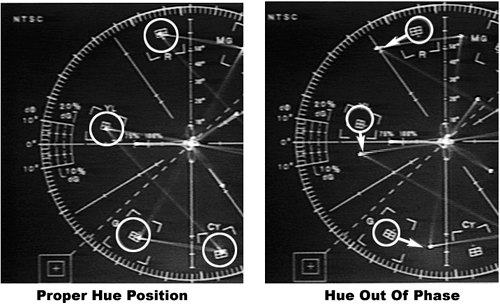Hue and Saturation
| I remember some of my first editing projects back when I didn't know a thing about properly calibrating my video decks. In the first project I edited, every living creature seemed to be tinted purple. Little did I understand that hue adjustment could have fixed this problem and returned the video signal colors to normal. If you have the luxury of having a vectorscope, you can adjust an image's hue (color phase) more accurately. The hue adjustment affects the color values for the entire scene globally, not just individual elements of that clip. If you look at your SMPTE color bar test pattern, as you adjust the hue, you should see the display on the vectorscope rotating, depending on which direction you adjust the slider (see Figure 6.27). Figure 6.27. The vectorscope is used to monitor the hue or phase of a video signal.
Saturation is the amount of color present in an image. Therefore, if you move the slider down to zero, you are in essence removing all the color values, thus turning the image into a black-and-white scene (absent of all color). If you boost the saturation value too high, you wind up getting an image that is so oversaturated with color that the colors begin to bleed out of the images and blend together, giving you a very bad attempt at a solarized image. note Keep in mind that oversaturated footage looks progressively worse for every generation you duplicate, especially on VHS tape. |
- Chapter I e-Search: A Conceptual Framework of Online Consumer Behavior
- Chapter III Two Models of Online Patronage: Why Do Consumers Shop on the Internet?
- Chapter IV How Consumers Think About Interactive Aspects of Web Advertising
- Chapter VII Objective and Perceived Complexity and Their Impacts on Internet Communication
- Chapter XVI Turning Web Surfers into Loyal Customers: Cognitive Lock-In Through Interface Design and Web Site Usability
